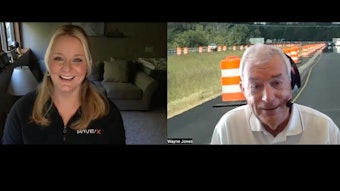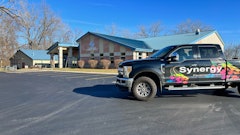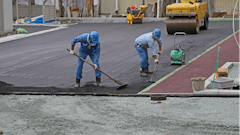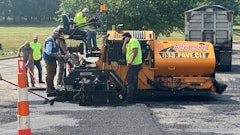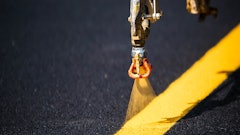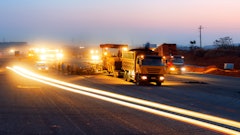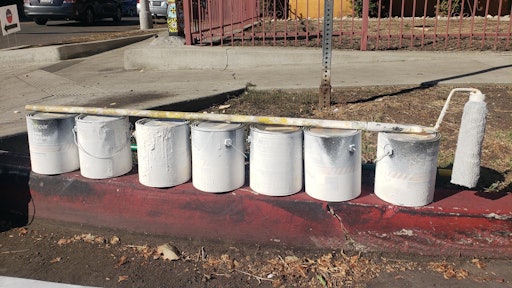
Sometimes it can seem like pavement striping doesn't get as much attention as the other aspects of this industry. It might not have the same cultural cache as, for instance, the actual paving process. Even sealcoating has a fairly large tradition behind it, and there are, without a doubt, sub cultures and groups of contractors who gravitate towards each other. Sweepers have multiple national organizations that they can belong to! But don't let the significance of striping be overlooked.
The real life, day-to-day worlds of a community are deeply impacted by the humble markings that line our city streets. One of the most important places where this rings most true is where pedestrians move from one sidewalk to another at crosswalk intersections. This is primarily where the pedestrian and the automobile directly confront each other in the same space. American cities are designed for cars. Despite this, people live, work, and, more importantly, they walk these cities in increasing number while advocates push for even more accessible communities in which to live in. And they want to do so safely, and without fear. But that isn't as easy as it sounds.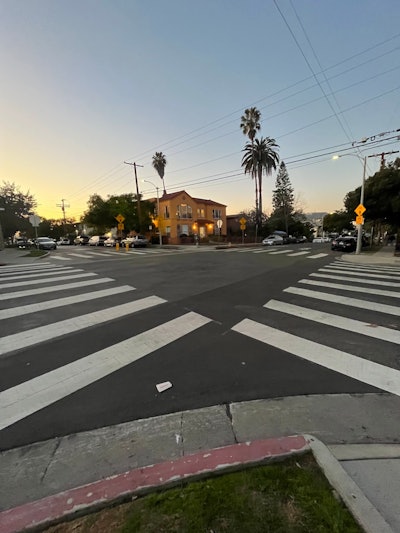
In 2015 Los Angeles Mayor Eric Garcetti said, “It is tragic that 200 people are killed each year while moving about our city,” in an August press release that has since been taken down. “I am determined to bring that number down to zero.” After this, the Mayor signed the "Vision Zero" initiative aimed at lowering pedestrian deaths to zero. They weren't the only ones. The cities of Chicago, New York, and San Francisco made pledges before the city of LA, but Tinsel Town jumped out of the gate and made serious strides, at first, transforming city infrastructure and instituting other changes in favor of pedestrian safety. However, things have not continued along that path
According to Los Angeles Police Department data, and reported on by the Los Angeles Times, through Dec. 25, 2021, 289 people were killed in traffic collisions last year, 21% more than the same period in 2020 and 19% over the same period in 2019. A total of 1,465 people were severely injured, a 30% increase over the same period in 2020. The city’s streets are increasingly dangerous for pedestrians in particular, with 486 being severely injured by motorists — a 35% increase over 2020. Pedestrian deaths rose 6% to 128.
In regards to the "Vision Zero" project, the executive director of Los Angeles Walks John Yi said, “We’re nowhere near it. This is a leadership failure at the city level.”
The Crosswalk Collective and Their Mission
As a state, California is ranked eighth in the country when it comes to pedestrian deaths [see Side Bar 2 for full list of ten deadliest states for pedestrians], and in it's most famous city, the citizens decided it was time to take matters into their own hands.
"Firstly, we're in Los Angeles, which is a very, very car centric city, every decision is looked at how it impacts traffic," said Jeff (an alias used to protect his identity), an active member of the Crosswalk Collective (CC). "Everything except car infrastructure takes the backseat. There is just no thought given to pedestrians and cyclists. Secondly, there is a complete lack of political will. We have faced extreme hostility from political policymakers. It's just complete opposition and antagonism toward anything that threatens their authority."
The group of "guerrilla stripers" first started taking action in February 2022, and by the end of that year they had installed roughly twenty rogue markings. According to the CC this action only came after repeated and ignored requests for the city to place sanctioned road markings at particularly dangerous walkways. While the city claims not to have the time or money to properly protect pedestrians, it has shown it has plenty of resources to remove the amateur striping, as less than half of their installations remain in place.
"An important thing for us is that we don't want to put anyone at risk," Jeff explained. "Whether drivers or people working in a crosswalk, traffic control is key. We are very careful." And one of the most important things to note about what they do is this. They do not add crosswalks to intersections, thus altering the established traffic dynamic. They simply take an intersection where unmarked crosswalks already exist, where the pedestrian right-of-way is present, and then they mark them.
However, the counter efforts by the city have only had the opposite of their desired effect. The removal of the CC crosswalks often draw the ire of locals in the community, stirring up greater dissatisfaction with officials, placing increased and deserved pressure on them. Or, in the case where some CC members were fined by the LAPD $250 in a citation, the news of it spread and led to a wave of donations and support from the residents. This raises a great question as the group continues its crusade. How does the Crosswalk Collective decide where to act?
"We try to be active in places that are under invested in by the city," Jeff continued. "If you go to the west side of Los Angeles, you have these beautiful crosswalks on brand new amazing pavement. So, we try to focus on Central, East, and maybe South-Central South Los Angeles--places where the city is not as present. You have to support those communities." The Crosswalk Collective website has a form where anyone in the city can place a request for an intersection to be marked. After it is submitted, the team reviews whether it is feasible.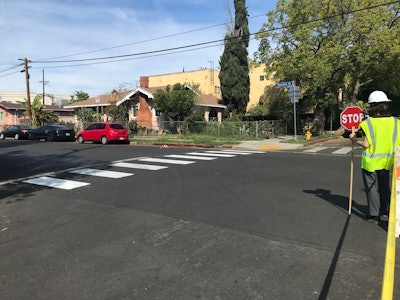
It might surprise you to learn that this "Robinhood" striping crew is made up of people who all work for a living, have full-time jobs they are responsible to, and their foray into the world of striping isn't something any of them had prior experience in. The Crosswalk Collective isn't even an officially formed non-profit, they are simply like-minded individuals who decided they could make a difference right where they live. For many of them, it is the very first time they've been involved in any type of community organizing.
How did they even get started? "Completely self taught," Jeff said. "Basically we went online, looked at resources, and tried it out. A few different methods, rollers versus paints sprayers, but we don't have the means for thermoplastics, yet, which actually is extremely expensive, so we're probably never going to be able to do it. We looked at what kind of paint would last despite the weather, despite traffic, and we also considered which is less environmentally harmful. After that we kind of had a few practice runs and just learnied on the job."
Whether or not you agree with their tactics, what motivates these volunteers is something real, measurable, and increasingly undeniable. Not only in LA, but all around the country, the danger posed to pedestrians in American cities is on the rise. Once you see what's really happening out there, the urge to take action in your own neighborhoods might make a lot more sense.
Facing the Problem in Front of Us
Near the end of November 2022, Transportation Secretary Pete Buttigieg held a press conference to denote the anniversary of the landmark piece of legislation, the bi-partisan Infrastructure Investment and Jobs Act (IIJA). However, the media event was also in response to growing concern for traffic and pedestrian related mortalities, which had garnered recent attention at the release of federal data estimating nearly 43,000 traffic fatalities in 2021, marking a 10.5% increase from the prior year.
“We know roadway deaths are preventable because some places are doing a much better job at preventing them — both abroad and within certain U.S. communities,” the Secretary added. “The U.S. Department of Transportation is committed to making real progress toward ending traffic fatalities, and we call on everyone to join us in this national effort that can only succeed when we work together.” Mr. Buttigieg is correct when he remarks that there are other parts of the developed world doing a much better job.
In fact according to a paper published February 22, 2023, The period of 2010–2020 saw a slowdown in pedestrian safety improvement in a few of the countries studied and listed below, but only in the USA did fatality rates increase–by an alarming 25% in only ten years. By comparison, the per-capita rate remained roughly the same from 2010 to 2020 in the UK and continued to fall in the other four countries: Canada (−7%), Germany (−16%), Japan (−19%), Denmark (−19%), and the Netherlands (−19%).
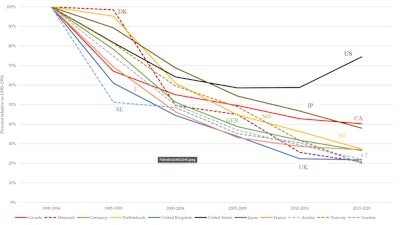
According to a press release by the Governors Highway Safety Association (GHSA), data analysis found that the recent increase in pedestrian deaths is even more alarming when you take 2019 into account. Pedestrian deaths have surged 18%, or 519 additional lives lost, between the first half of 2019 and 2022. Nationally, there were 1.04 pedestrian deaths per 100,000 people in 2022, up significantly from 0.90 in 2019.
The GHSA concluded that a combination of factors are at play, including a surge in dangerous driving that began at the start of the pandemic; larger, heavier vehicles that are more likely to seriously injure or kill people on foot; roads designed to prioritize fast-moving traffic over slower speeds that are safer for pedestrians; and inadequate infrastructure such as sidewalks, crosswalks and lighting in many parts of the country.
“A single roadway death is tragic. But it’s absolutely mind-boggling and heartbreaking that drivers are killing an average of 19 pedestrians every single day," said GHSA Chief Executive Officer Jonathan Adkins. "The only way to reverse this awful trend is to do more of everything that works – more and better designed infrastructure to keep people walking safe, equitable enforcement of traffic safety laws to stop dangerous driving and engaging more communities where the impacts of this crisis are felt the hardest.”
Celebrating the Wins
Jeff and his associates at the Crosswalk Collective haven't had any first hand dealings with professional stripers yet, but it is something they would welcome. Obviously, a business acting as a rogue striper has more at stake than a group of citizens acting independently, but guerrilla striping isn't the only way to help your community. As a business owner, one of the biggest things you could do is advocate for needed change. Engage with your local officials, perhaps volunteering and donating time and materials to complete long outstanding projects your city hasn't been able to complete. 
Those are some extreme examples of how to get involved, but there are still other more subtle, yet direct, ways. "It doesn't even have to be donations," said Jeff. "It doesn't have to be equipment either. Just the knowledge itself is so invaluable. And really, by doing the work we do now, we realized that this invisible work, and things like this that get done every single day, in different trades, it is so critical, and the way it's done is important. It really made us realize how important that knowledge is and to value that knowledge."
The Crosswalk Collective, the people behind it, and the community it works to protect see all these statistics play out in the real world every day. Sometimes their work is left in place by the city, where the removal would be too much trouble to send a crew out to strip away, and those are considered victories. However small they may be, one job in particular was a big win for CC and local residents.
Someone from the parent's association at a nearby school contacted CC after seeing their work be shared online by others in the area. They reached out desperately requesting crosswalks be painted next to an elementary school.
"Those were the first yellow crosswalks, which was a lot of fun, and they turned out amazing," said Jeff. After they were completed, perhaps the best possible outcome happened. The city came out eventually and re-painted them with the much more durable thermoplastic/reflective material. "I think it was too sensitive, because it was next to school. They couldn't in their right minds remove those crosswalks. For us, that was like, ok -- Let's keep doing it."






